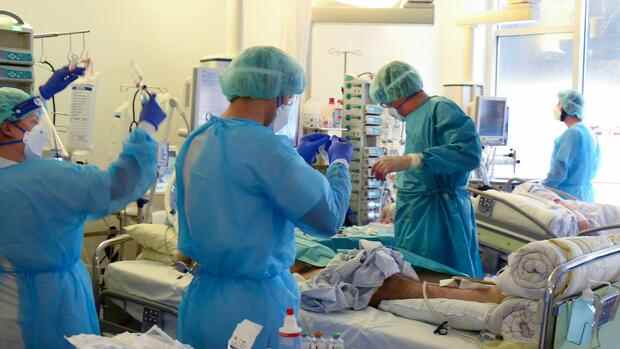The number of hospital admissions will in future be a hard indicator for combating the corona pandemic.
(Photo: dpa)
Berlin It is the new yardstick for corona measures in Germany: In future, the level of the hospitalization rate will decide on extensive contact restrictions in the federal states. What is when? An overview.
What the hospitalization rate means
For the hospitalization rate, the Robert Koch Institute (RKI) records the reported hospital admissions of corona patients per 100,000 inhabitants over a seven-day period. The value is currently 5.7 nationwide, the highest value measured so far last winter was 15. In federal states such as Thuringia (18.5) and Saxony-Anhalt (11.9) it is currently the highest, this is where the hospitals come in to their limits. In Hamburg it is the lowest at 1.6.
As early as August, the federal and state governments decided that the hospitalization rate should replace the incidence value as the new yardstick, as the increasing vaccination rate made the number of cases less informative for the utilization of the intensive care beds. Since then, the value has been used in many federal states as the basis for so-called corona traffic lights, which also include parameters such as the vaccination rate or the incidence values.
These corona traffic lights are now being standardized and tailored to the hospitalization rate. In Baden-Württemberg, for example, the value eight applies to the lowest warning level, the last level applies to a value of twelve. The values now set by the federal and state governments are much stricter.
Top jobs of the day
Find the best jobs now and
be notified by email.
Which limit values will apply in the future
Specifically, if a threshold value of 3 is exceeded, the federal states should only introduce nationwide access rules for vaccinated and convalescent people (2G), for example to events and the catering trade – if they have not already done so. If a value of 6 is exceeded, the federal states should also prescribe test certificates or other measures in certain facilities for vaccinated and convalescent people (2G plus).
At the latest when the threshold value of 9 is exceeded, the federal states should then make use of further restrictions. This aims at a clause resolved by the Bundestag: According to a corresponding state parliament resolution, the states should also be able to impose tougher measures such as contact restrictions or restrictions and bans on events.
criticism
The level of the limit values are based – like the incidence values in the previous waves – not on scientific findings, but are purely political decisions.
There is no data or experience to link any measures to the rate of hospitalization. This also means that the limit values can be set up or down like the incidence limit values - and can be supplemented by new measures. This harbors the risk that they appear arbitrary and thus undermine the understanding among the population for the sometimes far-reaching cuts.
There is also criticism of the survey. An NDR research at the beginning of October showed that the actual value was significantly higher than the originally reported, as the corona cases were sometimes reported by the hospitals with a considerable delay. Because the intensive capacities in the federal states also differ, the hospitalization rates are not necessarily comparable with each other.
The question of how the measures that go along with the yardstick can be controlled at all is also completely open. Up to now there has been far too little control, something that the federal and state governments have also stated in their decision.
Still there is criticism. For the stricter controls, the federal states should “exhaust” the range of fines, for their part increase the control density and punish violations decisively. However, retailers, restaurateurs and operators in local public transport have already pointed out that it is impossible for them to ensure comprehensive control.
More: Compulsory vaccination for medical professions and thresholds for contact restrictions planned
